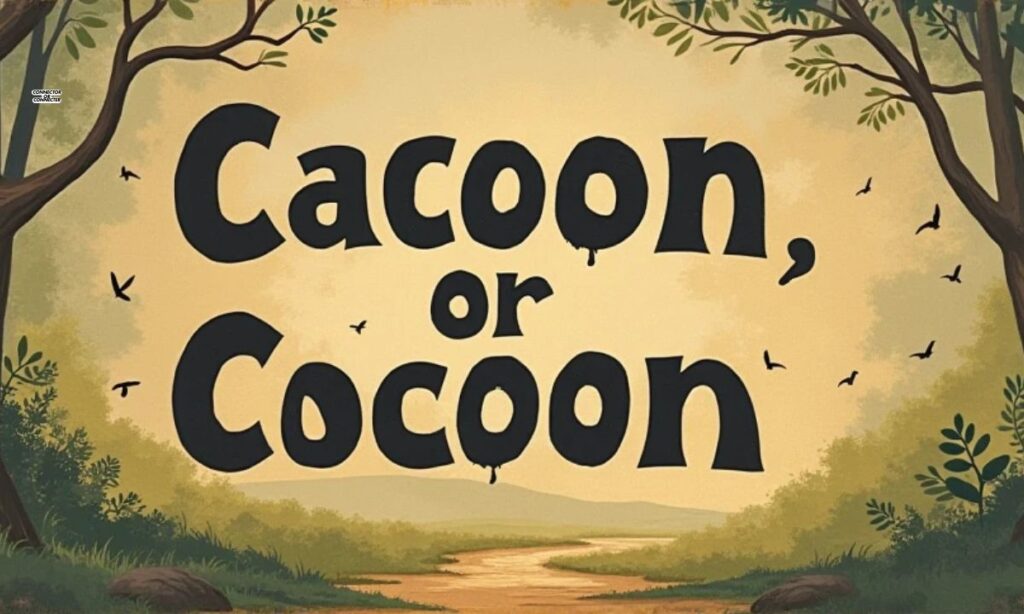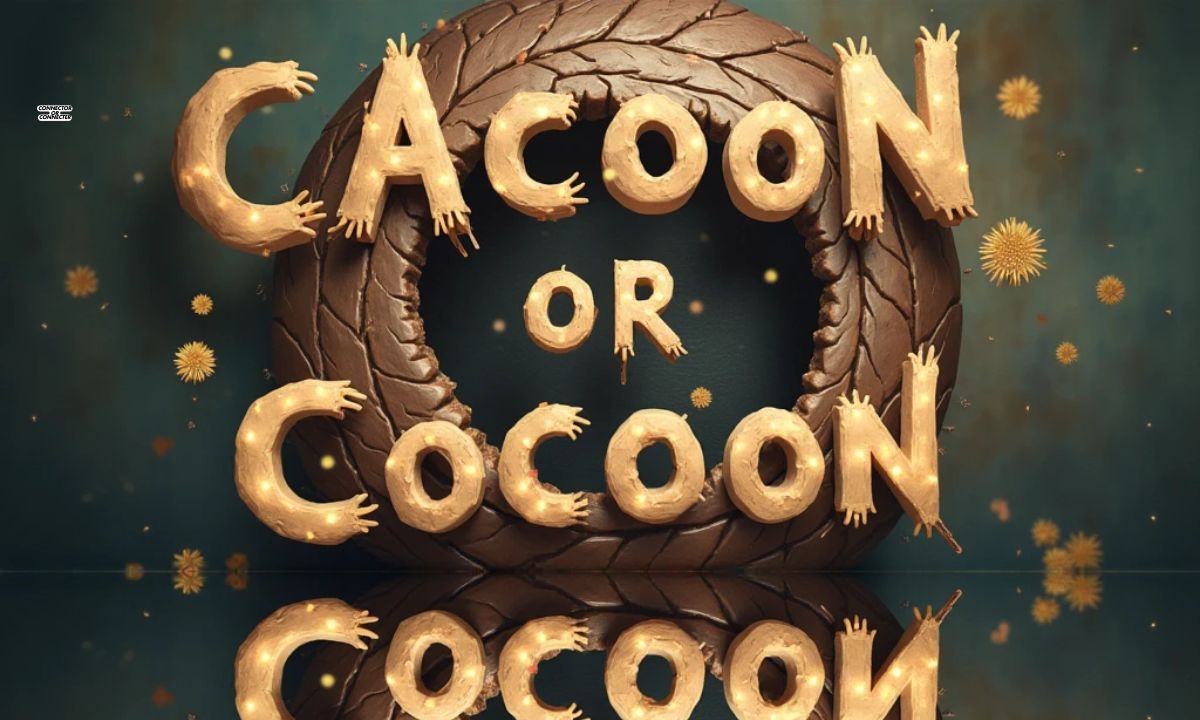In our journey through the English language, we often encounter words that trip us up. One such puzzling pair is “cacoon” and “cocoon.” Language often presents us with spelling conundrums that can affect our writing’s professionalism and clarity.
The confusion between “cacoon” and “cocoon” remains a common source of uncertainty for many writers, students, and professionals. Let’s explore this linguistic puzzle and settle the spelling debate once and for all.
This comprehensive spelling guide will unravel the mystery behind these terms and help you master their usage.
What Is a Cocoon? Understanding the Correct Spelling
In nature’s grand design, few structures are as fascinating as the cocoon. This remarkable protective casing represents one of the most extraordinary examples of natural engineering, where insects create their own safe haven for one of life’s most dramatic transformations.
The complexity and ingenuity of cocoon construction have inspired countless scientific studies and technological innovations.
Cocoon Definition and Meaning
A cocoon is a protective covering that certain insects, most notably silkworms and other moth caterpillars, create during their metamorphosis process. The word traces its origins to the French “cocon” and Latin “coccum,” highlighting its rich linguistic heritage.
The Oxford English Dictionary defines a cocoon as:
- A silky case spun by insect larvae for protection during transformation
- A protective covering or enclosed space providing safety or seclusion
- A state of protection or complete envelopment
Common Uses of the Word “Cocoon”
Beyond its biological origins, the term “cocoon” has woven itself into our cultural fabric in remarkable ways. From literature to technology, we’ve adopted this word to describe various forms of protective environments.
Modern architecture even incorporates “cocooning” principles in sustainable building design, creating spaces that protect occupants while minimizing environmental impact.
The term “cocoon” appears in various contexts:
- Biological context: Describes the protective shell created by insects
- Metaphorical usage: Represents safety, isolation, or transformation
- Design terminology: Refers to enclosed, protective spaces or furniture
What Is Cacoon? The Misspelling and Its Origins
The emergence of “cacoon” as a common misspelling reveals fascinating patterns in how language evolves through common usage and misunderstanding.
This variant spelling has persisted partly due to regional pronunciation differences and the influence of similar-sounding words, demonstrating how spoken language can impact written forms.
“Cacoon” is generally considered a misspelling of “cocoon.” This error often occurs due to:
- Phonetic confusion
- Regional pronunciation differences
- Similarity to words like “raccoon”
Note: There is a rare botanical exception where “cacoon” refers to specific tropical vines.
Cacoon vs Cocoon: Understanding the Differences
Examining these spelling variations reveals interesting insights into English language evolution and the impact of digital communication on spelling conventions.
While spell-check tools have helped reduce spelling errors, the persistence of “cacoon” in informal writing suggests deeper patterns in how we process and reproduce language.
Here’s a helpful comparison table:
| Term | Status | Usage Context | Correct? |
| Cocoon | Standard spelling | Biology, metaphors, design | Yes |
| Cacoon | Misspelling | Common error in informal writing | No* |
*Except in specific botanical references
Correct Spelling of Cocoon in Context
The context in which we use “cocoon” significantly influences its impact and meaning. Understanding these contextual nuances helps writers choose the most effective way to employ this versatile term, whether in technical writing or creative expression.
Scenario 1: Email about Silkworm Cocoon Project
“Dear Professor, Our research on silkworm cocoon formation has revealed fascinating patterns in protein synthesis during the protective covering development.”
Scenario 2: Email Using the Metaphorical Cocoon
“The pandemic forced many of us to cocoon at home, leading to significant changes in work patterns.”
Origins of Cacoon and Cocoon

The historical journey of the word “cocoon” reflects broader patterns in language development and cross-cultural exchange. Its etymology reveals fascinating connections between ancient silk trade routes and the spread of linguistic innovations across continents.
The word “cocoon” has evolved significantly:
- 1690s: First recorded use in English
- 1800s: Metaphorical usage emerges
- Modern era: Extended to design and psychological contexts
Botanical and Metaphorical Uses of Cocoon
The rich symbolic potential of cocoons has led to their adoption across various fields, from psychology to architecture. This versatility showcases language’s ability to adapt and expand beyond literal meanings to encompass broader conceptual frameworks.
Botanical Term Cacoon
In the realm of botany, the term “cacoon” serves as a rare exception to standard spelling rules, highlighting how specialized scientific terminology can sometimes diverge from common usage. This botanical usage provides an interesting case study in how technical language can preserve alternative spellings.
The rare legitimate use of “cacoon” refers to:
- Entada gigas (sea heart)
- Certain tropical climbing vines
- Specific seed pods in Caribbean flora
Cocoon in Interior Design
Contemporary design philosophy has embraced the concept of cocooning to create spaces that promote wellbeing and security. This application demonstrates how biological concepts can inspire innovative approaches to human-centered design.
Modern designers embrace cocoon-inspired elements:
- Enclosed seating
- Wrap-around furniture
- Protective spatial designs
Example of Cocoon Furniture in Interior Design
Modern furniture designers have revolutionized comfort by incorporating cocoon-inspired elements into their creations. These designs reflect a deep understanding of human psychology and our innate desire for protected, nurturing spaces.
Popular cocoon-style furniture includes:
- Egg chairs
- Pod seating
- Enclosed workspaces
- Canopy beds
Cocoon Symbolism
The symbolic richness of cocoons continues to evolve, taking on new meanings in our rapidly changing world. From digital cocoons to social cocooning, these metaphorical extensions reflect contemporary societal trends and concerns.
Cocooning as Isolation
The phenomenon of social cocooning has gained new relevance in our post-pandemic world, highlighting how language adapts to describe emerging social behaviors and psychological responses to environmental changes.
The concept of “cocooning” represents:
- Voluntary social withdrawal
- Personal transformation periods
- Safe space creation
- Self-care and protection
Cocoon Or Cacoon
When writing about protective casings formed by insects or cozy, enclosed spaces, it’s crucial to use the correct spelling. Let’s break down these commonly confused terms and their proper usage.
Cocoon Spelling
“Cocoon” is the correct spelling in almost all contexts. This word contains a double ‘O’ in the middle, mirroring the protective nature of the structure it describes. From silkworm cocoons to metaphorical usage in design and psychology, this spelling remains consistent across disciplines.
Key usage examples:
- “The butterfly emerged from its cocoon”
- “She created a cocoon of blankets”
- “The office pods provide a cocooning effect”
Spell Cacoon
“Cacoon” represents a common misspelling that often appears in informal writing. While it might seem logical due to pronunciation, it’s incorrect except in rare botanical contexts. The ‘a’ spelling emerged from phonetic confusion and regional variations in pronunciation.
Botanical exception:
- Refers to specific tropical vines
- Used in Caribbean flora terminology
- Describes certain seed pods
Spell Cocoon
To spell “cocoon” correctly, remember:
- Starts with ‘Co-‘
- Contains double ‘O’
- Ends with ‘-n’
Memory aids:
- Think “COzy-COON”
- Remember it shares double O’s like “moon”
- Visualize two O’s as the transformation stages
Whether you’re writing about biological metamorphosis, design concepts, or metaphorical transformations, stick with “cocoon” for proper spelling in standard usage.
Conclusion: Cacoon or Cocoon?
This exploration of “cacoon” versus “cocoon” reveals more than just correct spelling – it illuminates the complex relationships between language, meaning, and human experience.
Understanding these connections helps us appreciate why precision in language matters while acknowledging the dynamic nature of linguistic evolution.
Remember these key points:
- “Cocoon” is the correct spelling for most uses
- “Cacoon” is generally incorrect except in rare botanical contexts
- Use “cocoon” for all metaphorical and design-related references
Pro Tip: Think “cocoon contains two O’s, like the two stages of transformation it represents.”
Want to ensure perfect spelling? Remember this mnemonic: “Caterpillars Only Create OOzy Nests”

